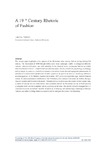Mostrar o rexistro simple do ítem
A 19th century Rhetoric of fashion
| dc.contributor.author | Popescu, Lorenta | es_ES |
| dc.date.accessioned | 2014-10-02T12:31:51Z | |
| dc.date.available | 2014-10-02T12:31:51Z | |
| dc.date.issued | 2012 | es_ES |
| dc.identifier.citation | Culture of communication / Communication of culture, 2012: 1035-1041. ISBN: 978-84-9749-522-6 | es_ES |
| dc.identifier.isbn | 978-84-9749-522-6 | es_ES |
| dc.identifier.uri | http://hdl.handle.net/2183/13417 | |
| dc.description.abstract | [Abstract] The present paper highlights a few aspects of the Romanian urban society fashion during thelong19th century. The Revolution of 1848 brought forth a new social paradigm, visible in changes at alllevels. Intricate relations with power and with authority, in the classical sense, accompany fashion as a daily element of social existence. It implies tradition and innovation, attitude, mentalities, psychology, technology and technique, art, taste etc., it acts like a dynamic, interactive, hierarchic and segregation phenomenon. In semiotics it is considered a paradoxical semantic system as its goal is «to deceive itsmeaning elaborated so extravagantly» (cf. R. Barthes, Système de la mode, 1967, p.10).As a symbolic sign, fashion betokens culture. It states a permanent celebration of the Otherness,which means it advocates an endless dialogue between systems and between individuals. Perceptionallows a continuous reinvention of the human body, a matter of concept able to create forms. And suchforms helped the Romanian society to build patterns to integrate itself into the European culture, a priority at the time. The people’s flexible engagement in a European discourse stimulated valuable perspectives of shaping and maintaining a meaningful lifestyle. Fashion was called to bridge these two systems and to configure the context for modernity. | es_ES |
| dc.language.iso | eng | es_ES |
| dc.publisher | Universidade da Coruña | es_ES |
| dc.title | A 19th century Rhetoric of fashion | es_ES |
| dc.type | info:eu-repo/semantics/conferenceObject | es_ES |
| dc.rights.access | info:eu-repo/semantics/openAccess | es_ES |






